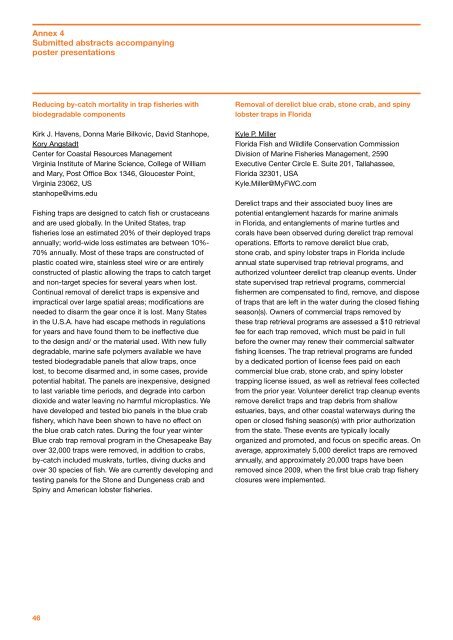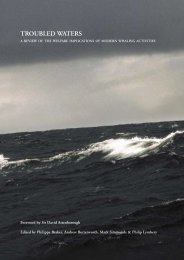Annex 4Submitted abstracts accompanyingposter presentationsReducing by-catch mortality in trap fisheries withbiodegradable componentsKirk J. Havens, Donna Marie Bilkovic, David Stanhope,Kory AngstadtCenter for Coastal Resources ManagementVirginia Institute <strong>of</strong> Marine Science, College <strong>of</strong> Williamand Mary, Post Office Box 1346, Gloucester Point,Virginia 23062, USstanhope@vims.eduFishing traps are designed to catch fish or crustaceansand are used globally. In <strong>the</strong> United States, trapfisheries lose an estimated 20% <strong>of</strong> <strong>the</strong>ir deployed trapsannually; world-wide loss estimates are between 10%-70% annually. Most <strong>of</strong> <strong>the</strong>se traps are constructed <strong>of</strong>plastic coated wire, stainless steel wire or are entirelyconstructed <strong>of</strong> plastic allowing <strong>the</strong> traps to catch targetand non-target species for several years when lost.Continual removal <strong>of</strong> derelict traps is expensive andimpractical over large spatial areas; modifications areneeded to disarm <strong>the</strong> gear once it is lost. Many Statesin <strong>the</strong> U.S.A. have had escape methods in regulationsfor years and have found <strong>the</strong>m to be ineffective dueto <strong>the</strong> design and/ or <strong>the</strong> material used. With new fullydegradable, marine safe polymers available we havetested biodegradable panels that allow traps, oncelost, to become disarmed and, in some cases, providepotential habitat. The panels are inexpensive, designedto last variable time periods, and degrade into carbondioxide and water leaving no harmful microplastics. Wehave developed and tested bio panels in <strong>the</strong> blue crabfishery, which have been shown to have no effect on<strong>the</strong> blue crab catch rates. During <strong>the</strong> four year winterBlue crab trap removal program in <strong>the</strong> Chesapeake Bayover 32,000 traps were removed, in addition to crabs,by-catch included muskrats, turtles, diving ducks andover 30 species <strong>of</strong> fish. We are currently developing andtesting panels for <strong>the</strong> Stone and Dungeness crab andSpiny and American lobster fisheries.Removal <strong>of</strong> derelict blue crab, stone crab, and spinylobster traps in FloridaKyle P. MillerFlorida Fish and Wildlife Conservation CommissionDivision <strong>of</strong> Marine Fisheries Management, 2590Executive Center Circle E. Suite 201, Tallahassee,Florida 32301, USAKyle.Miller@MyFWC.comDerelict traps and <strong>the</strong>ir associated buoy lines arepotential entanglement hazards for marine animalsin Florida, and entanglements <strong>of</strong> marine turtles andcorals have been observed during derelict trap removaloperations. Efforts to remove derelict blue crab,stone crab, and spiny lobster traps in Florida includeannual state supervised trap retrieval programs, andauthorized volunteer derelict trap cleanup events. Understate supervised trap retrieval programs, commercialfishermen are compensated to find, remove, and dispose<strong>of</strong> traps that are left in <strong>the</strong> water during <strong>the</strong> closed fishingseason(s). Owners <strong>of</strong> commercial traps removed by<strong>the</strong>se trap retrieval programs are assessed a $10 retrievalfee for each trap removed, which must be paid in fullbefore <strong>the</strong> owner may renew <strong>the</strong>ir commercial saltwaterfishing licenses. The trap retrieval programs are fundedby a dedicated portion <strong>of</strong> license fees paid on eachcommercial blue crab, stone crab, and spiny lobstertrapping license issued, as well as retrieval fees collectedfrom <strong>the</strong> prior year. Volunteer derelict trap cleanup eventsremove derelict traps and trap debris from shallowestuaries, bays, and o<strong>the</strong>r coastal waterways during <strong>the</strong>open or closed fishing season(s) with prior authorizationfrom <strong>the</strong> state. These events are typically locallyorganized and promoted, and focus on specific areas. Onaverage, approximately 5,000 derelict traps are removedannually, and approximately 20,000 traps have beenremoved since 2009, when <strong>the</strong> first blue crab trap fisheryclosures were implemented.46
Annex 4Submitted abstracts accompanyingposter presentationsResults and conclusions <strong>of</strong> <strong>the</strong> first “National CoastalCleanup Report Chile - 2011”. Aquatic EnvironmentDepartment, Directorate <strong>of</strong> Maritime Territory andMerchant Marine (DIRECTEMAR), Chilean NavyMichelle ManleyDirección de Intereses Marítimos y Medio AmbienteAcuático (DIRINMAR)Subida Cementerio #300, Playa Ancha, Valparaíso, Chilemmanley@directemar.cl; michellemanley@hotmail.comWe analyzed <strong>the</strong> statistics <strong>of</strong> <strong>the</strong> marine debriscollected by volunteers during <strong>the</strong> “International CoastalCleanup Chile 2011”, an initiative <strong>of</strong> <strong>the</strong> NGO “OceanConservancy” led by <strong>the</strong> Chilean Navy through <strong>the</strong>Aquatic Environment Department <strong>of</strong> DIRECTEMARsince 2007.The objectives <strong>of</strong> this Coastal Cleanup were to:1. Raise awareness <strong>of</strong> marine debris problem.2. Prevent marine debris entering ecosystems.3. Obtain statistical records (classification and quantity)<strong>of</strong> litter collected. 4.- Achieve information that can beuseful as a tool for environmental education and fordecision-making as well as administrative policies.The 5,221 volunteers cleaned 77 beaches from <strong>the</strong>nor<strong>the</strong>rn tip <strong>of</strong> Chile (Arica -18° 28’ 43” S, 70° 18’ 19”W) to Punta Arenas in <strong>the</strong> south (53° 10’ 1” S, 70° 56’1” W), collecting a total <strong>of</strong> approximately 34,8 tons <strong>of</strong>trash along 98.7 km (61,3 miles) <strong>of</strong> coastline, between30 September and 30 October 2011. Taking intoconsideration <strong>the</strong> nature <strong>of</strong> <strong>the</strong> data, this analysis isessentially qualitative.The five main types <strong>of</strong> debris collected were cigarettebutts: 32,333 units (32.4%), plastic bags: 9,035 units(9%), food wrappers: 6,904 units (6.9%), bottle caps:6,374 units (6.4%) and plastic bottles: 5,478 units (5.5%).This pattern is repeated on most <strong>of</strong> <strong>the</strong> beaches cleaned,and is very similar to <strong>the</strong> statistics collected during <strong>the</strong>2009 and 2010 coastal clean-up activities.However, some beaches presented variations,particularly <strong>the</strong> Coquimbo area (29° 54’ 28” S, 71° 15’15” W), which showed significant amounts <strong>of</strong> fisheriesand aquaculture related litter. It must be noted that thistype <strong>of</strong> debris has <strong>the</strong> potential to generate entanglement<strong>of</strong> marine fauna, generating lacerations and wounds(Clark, 2011).In <strong>the</strong> Coquimbo area, a total <strong>of</strong> 673 volunteers cleaned6 beaches, and <strong>the</strong> most common type <strong>of</strong> garbagecollected were cigarette butts (39.3%), plastic bags(11.1%), ropes (6.6%), bottle caps (6%), and nets (4.7%).68.6% <strong>of</strong> <strong>the</strong> garbage originating from fisheries oraquaculture in Coquimbo was from “Playa Grandede Tongoy”, which had <strong>the</strong> highest number <strong>of</strong> nets(400 units) and ropes (300 units), followed byGuanaqueros that had 200 ropes (no nets). The beachcleanup coordinator <strong>of</strong> <strong>the</strong> Coquimbo area (conv pers)clarified that <strong>the</strong> nets found in Tongoy where “lanterntype nets” commonly used for aquaculture <strong>of</strong> scallops,an important commercial activity in <strong>the</strong> region.In conclusion, cigarette butts were <strong>the</strong> main type <strong>of</strong>marine debris collected on most Chilean beaches,followed by plastic (bags, wrappers, bottles and caps).From this we can deduce that recreational activities onbeaches are <strong>the</strong> main source <strong>of</strong> this type <strong>of</strong> pollution on<strong>the</strong> beaches cleaned during <strong>the</strong> International CoastalCleanup in Chile (2011). The problem with plastic is thatit has a low degradation rate and can be accidentallyingested by marine animals (birds, fish, turtles, etc.).On <strong>the</strong> o<strong>the</strong>r hand, <strong>the</strong> large amounts <strong>of</strong> garbagefrom fisheries or aquaculture activities collected on“Playa Grande de Tongoy” in Coquimbo, could posea potential threat <strong>of</strong> entanglement.In Chile we do not have significant statistics onentanglement <strong>of</strong> marine fauna caused by nets, ropes, oringestion <strong>of</strong> garbage, never<strong>the</strong>less this does not meanthat it does not occur and may not always be <strong>of</strong>ficiallyreported. In 2003, Gonzalez et al reported a strandedturtle (Lepidochelys olivacea), found in “Caleta Lenga”(36°47’S, 73°07’W) near <strong>the</strong> coast near Concepciónin central Chile <strong>the</strong> year 2000, with a fish hook in <strong>the</strong>esophagus, which was probably <strong>the</strong> cause <strong>of</strong> death.The Scientific Advisory Panel <strong>of</strong> <strong>the</strong> UNEP report titled“Marine Debris as a Global Environmental Problem”(November, 2011), where a series <strong>of</strong> papers related toentanglement, were ga<strong>the</strong>red. It was noted that 260species are already known to be affected by plasticdebris through entanglement or ingestion, which can befatal. The report highlights that <strong>of</strong> 120 marine mammal47
















